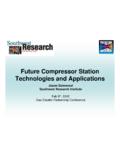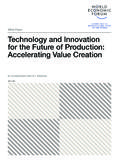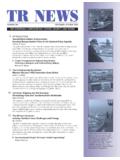Transcription of The impact of technology on the quality and …
1 Global Commission on THE future OF WORK. 6. issue brief Prepared for the 2nd Meeting of the Global Commission on the future of Work 15 17 February 2018 #. Cluster 3: technology for social, environmental and economic development The impact of technology on the quality and quantity of jobs The establishment of the Global Commission on the future of Work in August 2017. marked the start of the second phase of ILO's future of Work Centenary initiative. The six thematic clusters provide a basis for further deliberations of the Global Commission. They focus on the main issues that need to be considered if the future of work is to be one that provides security, equality and prosperity.
2 A series of Issue Briefs are prepared under each of the proposed clusters. These are intended to stimulate discussion on a select number of issues under the different themes. The thematic clusters are not necessarily related to the structure of the final report. List of Issue Briefs Cluster 1: The role of work for individuals and society #1. Individuals, work and society #2. Addressing the situation and aspirations of youth Cluster 2: B. ringing an end to pervasive global women's inequality in the workplace #3. Addressing care for inclusive labour markets and gender equality #4.
3 Empowering women working in the informal economy Cluster 3: T. echnology for social, environmental and economic development #5. Job quality in the platform economy #6. The impact of technology on the quality and quantity of jobs Cluster 4: Managing change during every phase of education #7. Managing transitions over the life cycle #8. Skills policies and systems for a future workforce Cluster 5: New approaches to growth and development #9. New business models for inclusive growth #10. Global value chains for an inclusive and sustainable future Cluster 6: The future governance of work #11.
4 New directions for the governance of work #12. Innovative approaches for ensuring universal social protection for the future of work Introduction Increased digitalization and automation is expected to significantly affect both the quality and quantity of jobs. New types of jobs and employment are changing the nature and conditions of work by altering skills requirements and replacing traditional patterns of work and sources of income. They open opportunities, especially for developing countries, to enter new, fast-growing sectors and catch up with more advanced economies. At the same time, new technologies are affecting the functioning of labour markets and challenging the effectiveness of existing labour market institutions, with far-reaching consequences for the number of jobs, their quality and the diversity of opportunities they offer.
5 This Issue Brief discusses the potential of technological change for job creation and destruction and its implications for inequality and job polarization. It also highlights the opportunities for economic development and labour market efficiency and inclusion. Key findings technology and jobs Current studies emphasize the disruptive nature of technological changes, stressing the potentially wide-ranging implications for job destruction (ILO, 2017). Evaluations of the extent of labour market disruption vary widely and range from a low of less than 10 per cent of all jobs to a high of more than 60 per cent (see Balliester and Elsheikhi, forthcoming, for an overview).
6 Frey and Osborne (2017) estimate that 47 per cent of US. jobs are susceptible to potential technological replacement. However, such assessments tend to overestimate the potential adverse effects of automation by focusing exclusively on the technical feasibility of substituting labour by capital. Thus, they ignore economic feasibility, whether the investment in new technologies is at least as profitable as existing (labour-intensive) alternatives (Kucera, 2017). future automation is unlikely to destroy complete occupations but will rather change the types and number of tasks in most occupations.
7 According to the World Bank, less than 20 per cent of jobs are predicted to disappear completely (World Bank, 2016a;. see also Autor and Handel, 2013). A recent study by McKinsey Global Institute that looked at both sides of the debate estimated that by 2030, in about 60 per cent of occupations, at least one-third of constituent activities could be automated (MGI, 2017). While this is likely to have a differential impact in different countries, the full- time equivalent of work potentially displaced by automation is estimated at a midpoint of 15 per cent. In addition, between 3 and 14 per cent of the global workforce would need to switch occupational categories (see Issue Brief No.)
8 8). Thus, while there might well be sufficient job creation to compensate for technological unemployment, the realization of these opportunities will depend on ensuring that workers can move to newly created jobs. In short, a bigger challenge may well be how to manage this transition (see Issue Brief No. 7). 1. History points to similar experiences. An often-cited example is the impact of the introduction of ATMs on jobs for bank tellers in the United States in the 1970s. Instead of as one might have assumed bank teller jobs being eliminated, their number rose modestly despite the rapid roll-out of ATMs (Bessen, 2015).
9 In France, the Internet is thought to have destroyed some 500,000 jobs within 15 years after its introduction;. at the same time, it has created million new jobs (MGI, 2011). One important reason for this is the reduction in operating and transaction costs resulting from these technological innovations, which can indirectly stimulate the demand for labour. Technological change can also create a range of new tasks; for instance, from a bank teller to a financial services advisor. In the United States, for example, 30 per cent of the jobs created since the late 1990s were types that did not exist before, such as IT administration, hardware manufacturing and development of smartphone applications (MGI, 2017).
10 Jobs are typically made up of both readily automatable and not readily automatable tasks. This raises the question of whether the automation of work processes will result in a reduction of the workforce, or whether the remaining tasks might be shared among the existing workforce. The answer to this question depends on how work is organized in a given workplace and on the extent to which tasks that are not readily automatable can be bundled together to create a new job (Kucera, 2017). The automation of work processes need not present an all or nothing scenario; different options do exist.
















